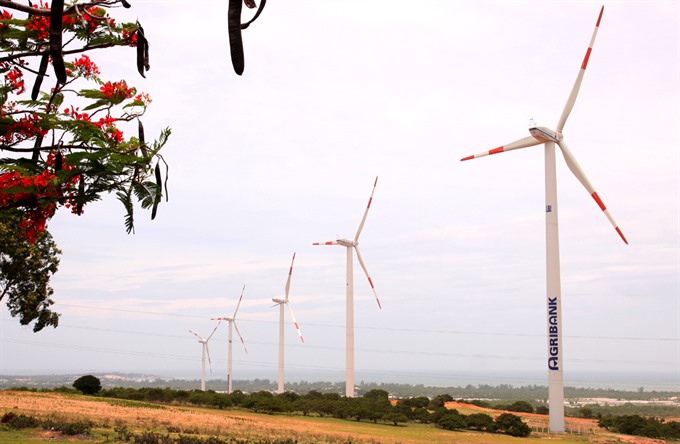 Economy
Economy

As Ninh Thuận Province is striving to become a national centre of renewable energy, local authorities, scientific and economic experts are optimistic about the province’s solar power plants and wind farms’ positive impact on socioeconomic progres
 |
| Wind turbines erected by the Vietnam Renewable Energy Joint Stock Company in Ninh Thuận Province. — VNA/VNS Photo Ngọc Hà |
HÀ NỘI — Officials say Ninh Thuận Province’s plan to become a national renewable energy hub is a sound one that will positively impact its socioeconomic progress.
Phạm Đăng Thành, Director of Ninh Thuận provincial Department of Industry and Trade (DIT), told the Vietnam News Agency that the province saw the renewable energy industry as a breakthrough for local economic growth.
The development of industrial solar power projects in Ninh Thuận Province will continue rapidly till 2020, Thành said.
Phạm Văn Hậu, Vice Chairman of the Ninh Thuận People’s Committee, also told VNA that the province has so far issued investment certificates for eight wind power projects with a total investment capital of VNĐ19.7 trillion (US$876 million) and total annual capacity of 514 megawatts.
Hậu said the province will always opt for the most capable, experienced and committed investor for the renewable energy sector.
Thành, said the province has completed a wind power development plan with vision until 2030. This involves the construction of five separate wind farms over 21,432 hectares. By 2030, their combined estimated annual capacity will be 1,429 megawatt, generating 5.4 million kilowatt of electricity in total.
In addition to this plan, the Ninh Thuận Provincial People’s Committee has instructed the local Industry and Trade department to co-ordinate with the Power Engineering Consulting Joint Stock Company 4 to formulate a solar power development plan for 2030.
Thành said that the province has adopted many preferential policies and enabling legal corridors to attract investors in the field of renewable energy, like land rent exemption, 10 per cent corporate income tax rate throughout the life of the project, and 50 per cent tax reduction for the next nine years.
The following decade is set to witness a series of solar power projects implemented by the provincial Department of Planning and Investment, as well as private companies in collaboration with foreign partners and the local Farmers’ Association, Thành added.
Lê Kim Hùng, Director of Ninh Thuận Provincial Department of Science and Technology, said that the region has great potential for solar energy, with the highest annual sunshine duration in the country, and little seasonal difference in solar radiation.
As such, investment in solar power systems has been increasing. The hope is to double their efficiency by 2030, lowering production costs and electricity prices, said Hùng.
He said the cost of solar power projects has been reducing since 2006, dropping from VNĐ168.7 million ($7,500) per kilowatt to VNĐ21.8 million ($907) in 2016.
Hùng also confirmed that by early 2018, Ninh Thuận Province would have started six more solar power projects, all of which have completed site clearance and environmental impact assessments.
Nonetheless, he admitted that the lack of Electricity of Việt Nam’s constant presence in all major provincial projects makes it hard for the distribution network to function properly.
He recalled that even prior to 2000 the province’s postal sector had already made use of solar panels to supply electricity to post offices in remote communes outside the national grid. — VNS




